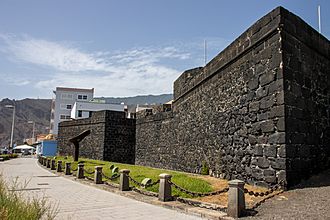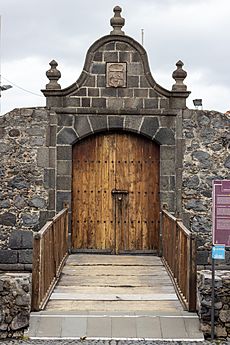Castillo de Santa Catalina (La Palma) facts for kids
Quick facts for kids Castillo de Santa Catalina |
|
|---|---|
 |
|
| General information | |
| Type | castle |
| Location | Santa Cruz de La Palma, Canary Islands |
| Coordinates | 28°41′13″N 17°45′38″W / 28.68694°N 17.76056°W |
| Designations | Bien de Interés Cultural (1951) |
The Castillo de Santa Catalina is an old castle in Santa Cruz de La Palma. This city is on the island of La Palma in the Canary Islands. The first castle was built between 1554 and 1560. This happened after French pirates attacked the city in 1553. The castle you see today was built later, from 1685 to 1692. It became a protected historical monument in 1951. Since 1949, it has been owned by private people, but you can visit it!
The First Castle
In 1553, French pirates attacked Santa Cruz de La Palma. This happened on July 21. After the attack, the town decided to build strong defenses. Work on the first Santa Catalina castle began in 1554. It was ready to be used by September 1560.
This first castle had an oval-shaped platform and a round tower. Its design was updated in 1585 by Leonardo Torriani. By the mid-1660s, the castle started to fall apart. The sea and big storms caused damage. For example, a storm on January 14, 1671, caused problems. The castle was in ruins from about 1666 to 1681. After that, it was taken down.
The New Castle
The castle you see now was built from 1685 to 1692. It stands right behind where the old castle used to be. The land for it was bought in November 1683. People helped pay for the first part of the building. They raised 30,000 silver reales. The island's government paid the rest in 1686.
This castle looks like military buildings from 16th-century Italy. It has a square shape. There are triangle-shaped strong points, called bastions, at each corner. It also has a wide raised area and a ditch, called a moat. A wooden bridge crosses the moat. The main entrance, now on calle Castillete, shows the coat of arms of the Catholic Monarchs of Spain. Inside, there is a room for weapons, a place to store gunpowder, and dungeons. There is also a storage area. The castle had a house for the governor and soldiers. It was used as a place for soldiers and a prison. A famous prisoner there was the lawyer Anselmo Pérez de Brito.
This castle was the most important defense for the city. Its design is similar to the Castle of San Cristóbal in Tenerife, which is now gone. That castle also had a square shape with a strong point at each corner.
Saving the Castle
The castle had soldiers guarding it until 1808. In 1883, a list of everything in the castle was made. By 1924, the army said it was not good for military use anymore. They decided to sell it. The castle was sold at an auction on February 17, 1949. A group of business people bought it for 300,000 pesetas. They wanted to tear it down and build houses. But the Spanish government stopped them. A special rule was made on April 22, 1949, to protect Spanish castles.
The castle was officially named a Historic Monument on June 22, 1951. This was written in the Boletín Oficial del Estado, which is like an official government newspaper. It was also added to the Spanish Historical Heritage list in 1985. It is the only old castle from the Habsburg era that is still standing in the Canary Islands.
The city council and the castle's owners made an agreement. Because of this, tourists have been able to visit the castle since May 2015. It was closed for a short time at the start of 2020.
In front of the castle, there is a sculpture about trade winds. It was made by Martín Chirino and is called 'El Alisio'. It was put there in 1999 and fixed up between 2014 and 2016.
See also
 In Spanish: Castillo de Santa Catalina (La Palma) para niños
In Spanish: Castillo de Santa Catalina (La Palma) para niños



